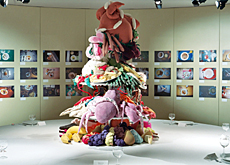Food exhibition serves up sensual feast

A feast for all the senses awaits visitors to an exhibition in Bern.
“Food Design” shows that there is much more to food than flavour by exploring the links between preparation and packaging, and offering a menu to suit all tastes.
None of the exhibits on display is actually edible – the “foodstuffs” are made of plastic and other materials.
But from its hors d’oeuvres through to dessert, the exhibition in Bern’s Kornhaus forum is a sensual and intellectually appetising culinary experience.
It begins with a presentation of what the average adult Swiss consumes in a week. Not surprisingly dairy products are prominent, but there is also a healthy mix of fresh fruit and vegetables.
However, the Swiss diet also consists of red meat, 900 grams of sugar and 80 grams of salt, and perhaps too much cooking oil.
Convenience food
The exhibition then moves on to a section devoted to convenience food and, more interestingly, examines its history.
For a relatively small country, Switzerland has produced a disproportionate number of food industry pioneers: household names like Nestlé, Maggi, Wander and Bircher-Benner.
It was the latter who in the late 19th century concocted the first recipe for muesli.
Wander produced among other things, Ovomaltine – called Ovaltine in the English-speaking world – while Maggi revolutionised the marketing of powdered and canned foods such as soup.
Packaging
Curator Claudia Cattaneo of Winterthur’s design museum told swissinfo: “Attractive packaging played an important role from the start, although no food was marketable unless it had a satisfying taste.
“This was not just a matter of being visually pleasing,” she said. “Food must be pleasant to touch and even its sound is helpful to sales.
“For example, television commercials for food products often show how they might be crunchy or juicy.”
To illustrate the point, Cattaneo and her colleagues have installed an interactive section, where visitors can smell ingredients and judge products by colour, appearance and texture.
They can also listen to recordings of people munching their way through apples, carrots, potato crisps and even sausages.
Eating habits
The exhibition ends with a look at artificially produced food and future laboratory research. It provides a great deal of food for thought: it informs, entertains – and asks questions.
For example: “Does the perfect tomato exist?”
“It does,” says Cattaneo, pointing out that there are at least 1,000 different varieties.
“The perfect tomato has to be firm with a round shape and neither too juicy nor too dry. Colour is also important. And so of course is the role played by nature in its cultivation.”
It’s heartening to note that nature is still a factor. But as laboratory experiments bring an ever-increasing number of varieties onto the market, could it be that one of the treats in store is “the designer tomato”?
“Food Design” is at the Kornhaus until June 8.
swissinfo, Richard Dawson
“Food Design” explores the links between preparation and packaging to find out what makes a product sell.
The exhibition takes a look at Swiss food industry success.
An interactive section enables visitors to smell ingredients and judge products by colour, appearance and texture.
Visitors can listen to recordings of people crunching their way through apples, carrots, potato crisps and even sausages.

In compliance with the JTI standards
More: SWI swissinfo.ch certified by the Journalism Trust Initiative
You can find an overview of ongoing debates with our journalists here . Please join us!
If you want to start a conversation about a topic raised in this article or want to report factual errors, email us at english@swissinfo.ch.